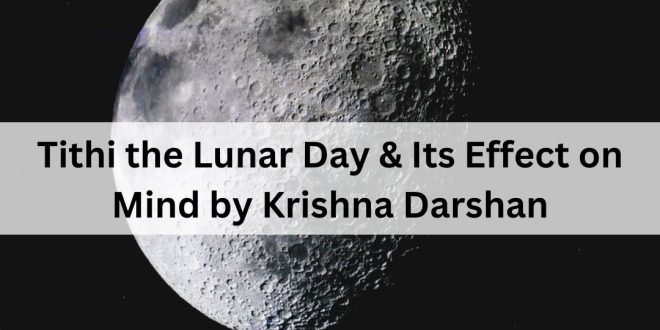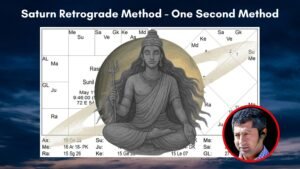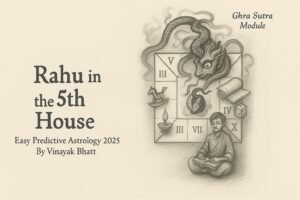Tithi the Lunar Day and Its Effect on the Mind by Krishna Darshan
Tithi the Lunar Day and Its Effect on the Mind
The Sun and the Moon have a powerful effect on human life and mind.
The Sun affects the life force, physical strength and the strength of the personality.
The Moon affects the mind, emotions, mood, and the process of growth and nourishment.
Both Sun and Moon represent the two poles of the Universal Energy, masculine and feminine, the universal father and mother, hot and cool, Siva and Shakti, Ying and Yang, etcetera.
Without the Sun there would not be life at all on earth. The closeness and distance of the earth from the Sun changes throughout the year and determines the seasons, like winter, spring, rainy or dry seasons and so, according to the location on earth. The waxing and waning cycle of the Moon is very well known to affect the ocean tides, the growth of plants, the fertility cycle in females, as well as the mind, emotions, and mood. Even people who proclaim themselves as non-believers in astrology, know that the cycles of the Sun and the Moon will affect a great deal of their lives, and everyone plans their lives, activities, clothing, vacations, and many other aspects of daily life based on “predicting” the seasons, weather tendencies and their effects on the mind.
People working in agriculture, farming and gardening know from ancient times that certain activities should be done in new Moon, others on crescent Moon other on waning Moon and so. Isn’t all that a form of popular electional astrology or “Muhurtha”- choosing and planning the best time to do certain activities to get the best results?
If we act in accordance with the energies in nature, we get mental peace and harmony. But if you want to, let’s say, sowing certain seeds in the beginning of the winter, you will waste your energy, feel out of tune and disappointed. The ancient Yogis and Rishis observed the effect of the Sun, the Moon and the planets with a much deeper and detailed knowledge. The Hindu calendar, called “Panchanga” is based on 5 factors relative to the position of the Sun, the Moon and the relationship between the two at any particular time.
All the religious life, holidays, festivals, fasts and performance of specific rituals in the Hindu culture are based on that “luni-solar” calendar.
The Great Yoga Master Swami Sivananda wrote:
“The lunar days influence the function of the Nadis (astral energy channels).
It should be borne in mind that the Moon exercises a powerful influence over the human mind. In the Purusha Sukta you will find:-Chandrama Manaso Jatah- the Moon is born of the mind of the Virat Purusha or Cosmic Being.
In the cosmos, the Moon is controlled by the cosmic mind. The individual mind being a speck of the cosmic mind has therefore the connection with the Moon, and being only a speck it feels controlled by the Moon.
When the Moon waxes and wanes, its connection with the mind also fluctuates and thus, there arises a sympathetic reaction in the mind. Hence, the relationship between the flow of the breath and the lunar days.” Sw. Sivananda
Yogis know the relationship between the Sun and Moon energy on the human life and mind through its effects on the flow of energy within the Nadis or astral tubes. There are two most important nadis called Ida and Pingala, also called the Moon and Sun nadis, which control all the processes of the physical chemistry and metabolism as well as the way the mind works. These two nadis are connected to the two nostrils, Ida or Moon energy to the left, and Pingala or Sun to the right nostril. One of these nadis or nostrils is predominant during a period of approximately 1 ½ hours and then it alternates. That regular alternation keeps the balance between heat and cold, effort and relaxation, sympathetic and parasympathetic nervous systems, body and mind, extroversion and introversion of the mind, concrete or abstract thinking. When these two nadis are kept in perfect balance for a long period of time, by the practice of Yoga, then another nadi called Sushumna becomes active, and that leads to an alternate state of consciousness and the experience of meditation, the transcendence of all dualities on the mind.
There is a great knowledge called “Swara Yoga” which studies in depth the effect of the Solar and Lunar energy in relationship with the breath and how it affects human life, result of an action and state of consciousness. The practice and self-discipline by which the practitioner can have a control over these flows of energy and directs them toward the perfection of the meditation experience that is called “Hatha Yoga” which means “union of the Sun and Moon energy”. They are both sister and complementary practices.
Swara Yoga is much related to the science of Jyotish and deeply understands the connection between the astronomical position of the Sun and the Moon and how it affects in the flow of the nostrils and its effects in life. Even predictions about different domains of life can be made according to the flow of the right or left nostril at a particular moment of a query, but its main goal is to attain spiritual consciousness and illumination.
According to the Swara Yoga Shastra, the nostril and Nadi that should be opened at the beginning of each day, at the time of sunrise should be as follows:
In the waxing cycle, on Tithis 1,2,3,7,8,9,13,14,and 15, the Moon (left Nadi) should flow first. On the 4,5,6,10,11,12 Tithis the Sun nadi should begin In the waning cycle, it is the reverse, meaning, on Tithis 1,2,3,,7,8,9,13,14,and 15 the Sun nadi should flow first, and the Moon on the rest.
If this happens, the mind feels peaceful and in harmony, and if the opposite happens, there is restlessness, and stress in the mind, which can also lead to disease. The flow of the nadis can be corrected by specific yoga practices and purification of the nadis. The practices should be learned from a qualified yoga teacher. Within the Panchanga or five limbs of the Hindu calendar, the Tithi or Lunar day plays a very important role to understand the propensities of the mind for different kind of activities, and the experience of emotional fulfillment.
There are certain Tithis which are favorable for certain activities and not for others. Certain Tithis are most favorable for meditation or worship of certain forms of God, while other Tithis are most favorable for attaining success in worldly activities, and others are more destructive in nature. The Tithi or lunar day plays a very important role in the branch of Jyotish called “Muhurtha” or choosing the auspicious time for a particular activity. It is also important in Natal astrology, because people born during certain Tithis have different mental tendencies, which should be considered together with the other planetary factors in the birth chart reading. On a spiritual dimension, the Sun represents the Soul or Atman; the Moon represents the soul’s reflection in the mind, the Jiva or individual self. The Scriptures describe the Sun of Lord Siva and the Moon as Goddess Parvati. The relationship between the Sun and the Moon shows the relationship between the soul and the individual mind, the internal and external life, the eternal and the living, the unchangeable and the changeable.
What Is A Tithi?
The Tithi is the distance between the position of the Sun and the Moon at a particular time. The moment the Sun and the Moon are conjunct, on the same degree, it is the New Moon. From there, each 12 degrees that the Moon gets separated from the Sun is one Tithi.
There are 30 Tithis in one lunar month, between one new Moon and the next.15 Tithis belong to the waxing fortnight or bright half of the month and 15 Tithis belong to the waning fortnight or dark half o the month Each of the 2 cycles or fortnight is called a “Paksha”. The waxing cycle is called the Sukla Paksha (from the new Moon to the full Moon). The waning cycle is called the Krishna Paksha (from the full Moon to the new Moon). Tithis are named from 1 to 15 starting from the beginning of the Paksha that they belong to. For example, the first Tithi after the New moon is called Sukla Pratipada, and the first Tithi after the Full moon is called Krishna Pratipada.
Groups of Tithis
Tithis are classified into 5 groups.
- Nanda Tithis
1, 6 and 11 are the Nanda Tithis. Nanda means happiness. Those are good days for activities relevant to obtain happiness and pleasure, like entertainment, arts, social encounters and the like.
- Bhadra Tithis
2, 7and 12 are the Bhadra Tithis.
They are good for activities related to the attainment of success and prosperity, such as business, beginning a job, etc.
- Jaya Tithis
3, 8 and 13 are the Jaya Tithis. Jaya means Victory, and those are good for activities done for the overcoming of obstacles, or for attainment of success, like competitions, litigations, examinations, efforts, etc.
- Rikta Tithis
4, 9 and 14 are the Rikta or “empty” Tithis.
They are the most “negative” Tithis for good actions, they are related to destruction, but they can be favorable for actions done to get rid of something, breaking, demolishing, cleaning, purifying, waste disposal, destroying something negative or pay a debt.
- Purna Tithis
5, 10 and 15 are the Purna Tithis.
Purna means fullness or completion. Those are good Tithis for activities done to complete something, abundance, harvesting crops, education, etc.
Presiding Deity
The Deity that rules a Tithi tells us much about the particular energy of that day.
The Tithi that you are born at, gives you a connection to one particular aspect of God, that should be understood and worshiped to get mental happiness. The Vedic tradition prescribes rituals and Mantras to propitiate the Presiding Deity of the Tithi, when an important activity is started on a particular day. People born under the Rikta Tithis (or other tithi afflictions) are advised to understand, worship, or repeat the Mantra of the Presiding Deity, as a form of remedial measure to be protected from adversities.
Tithi Table:
| Tithi | Degrees | Degrees | Sanskrit | Presiding | Nature | Group |
| Sukla | Krishna | name | Deity | |||
| Paksha | Paksha | |||||
| 1 | 0-12 | 180-192 | Pratipada | Agni | Increasing | Nanda |
| 2 | 12-24 | 192-204 | Dwitya | Brahma- | Auspicious | Bhadra |
| Aswini | ||||||
| Kumaras | ||||||
| 3 | 24-36 | 204-216 | Tritya | Gauri | Strong | Jaya |
| 4 | 36-48 | 216-228 | Chaturthi | Yama- | Cruel | Rikta |
| Ganesha | ||||||
| 5 | 48-60 | 228-240 | Panchami | Sarpa- | Prosperous | Purna |
| Saraswati | ||||||
| 6 | 60-72 | 240-252 | Shashti | Kartikeya- | Glorious | Nanda |
| Subramanya | ||||||
| 7 | 72-84 | 252-264 | Saptami | Surya | Friendly | Bhadra |
| 8 | 84-96 | 264-276 | Ashtami | Siva-Shakti | Conflictual | Jaya |
| 9 | 96-108 | 276-288 | Navami | Durga | Fierce | Rikta |
| 10 | 108-120 | 288-300 | Dasami | Dharmaraja- | Gentle | Purna |
| Yama | ||||||
| 11 | 120-132 | 300-312 | Ekadasi | Vishwadevas- | Blissful | Nanda |
| Kubera | ||||||
| 12 | 132-144 | 312-324 | Dwadasi | Vishnu | Glorious | Bhadra |
| 13 | 144-156 | 324-336 | Trayodasi | Siva, | Victorious | Jaya |
| Kamadeva- | ||||||
| Dharma | ||||||
| 14 | 156-168 | 336-348 | Chaturdasi | Siva-Kali- | Fierce | Rikta |
| Rudra | ||||||
| 15 | 168-180 | Purnima | Chandra- | Gentle | Purna | |
| Soma- | ||||||
| Vishwadevas | ||||||
| 15 | 348-360 | Amavasya | Pitris- | Ancestral | Purna | |
| ancestors | ||||||
| (tarpanam) | ||||||
Favorable and Unfavorable Tithis
The Brightness of the Moon is an indicator of its strength and auspiciousness.
The closest it is to the Sun, either before or after the new Moon, the more inauspicious or malefic it can be. For any action to bear a good fruit and be successful, the Moon should be strong. Therefore, the first 5 Tithis of the Sukla Paksha or Waxing Moon and the last 5 Tithis of the Krishna Paksha or Waning Moon should be avoided to begin activities which are supposed to grow, last and bring happiness. But they can still be very good for spiritual practices done without expectations.
The effects of the 2 Pakshas, waxing and waning Moon In the waxing cycle, the Moon is newly born and grows, expands towards fullness. So, the Shukla Paksha is more auspicious for starting work to accomplish something which is supposed to grow, expand, prosper and last, like, important inaugurations, starting of a new business, getting married, etc.
People born on this cycle are usually more industrious, outgoing, emotionally extroverted and successful in their endeavors.
In the waning cycle or Krishna Paksha, the Moon goes from its full radiance to its maximum darkness, so it is inauspicious for the actions mentioned before, but it can be a good time for purification, fasting, introspection, withdrawing from the material worldliness, letting go, develop humility, finish or extinct something.
People born on this cycle are usually are usually more introverted, shy or have more difficulties to relate in the emotional realm.
Some Tithis especially auspicious for spiritual practices.
Some Tithis are specially regarded as auspicious for meditation, worship and spiritual practices, like the Ekadasi, Trayodasi, Purnima o Amavasya.
Ekadasi
The Moon has an effect on the flow of prana in the nadis and chakras of the subtle body. In Shukla Ekadasi, the prana is naturally brought to the Ajna chakra and in the Krishna Ekadashi it does to the Anahata chakra. Those two are the most important chakras for meditation in various yoga systems. To help and not disturb this process and take maximum advantage of it, yogis and devotees usually fast on this day, some observe vigil the whole night and do Japa, Kirtan and meditation. Those who are unable to fast completely can take some light fruit and milk. It is said that no rice should be taken on Ekadasi days. This is very important. The sweat that fell down from the head of Brahma assumed the form of a demon and said to the Lord, “O Lord! now give me an abode to dwell.”
Brahma replied, “O demon! go and dwell in the rice particles eaten by men on Ekadasi day and become worms in their stomach.” For this reason, rice is traditionally avoided on Ekadasi.
Trayodasi
Trayodasi or the 13th lunar day is a very auspicious Tithi. It is also called “Pradosha” which means “without flaw”
Here is the Yogic interpretation of the Pradosha, (as explained by Swami
Sivananda):
“According to the Shiva-Raja Yoga, concentration is directed towards the central point in the middle of the eyebrows, where the spiritual light can be perceived by the Yogi who turns the vision inwards. The Yogi passes through various stages, all of which are subdivisions of the four states of waking, dreaming, deep sleep, and the Superconscious State or Samadhi. Each one of these states is further sub-divided into four states, for example, the waking-dreaming, waking-sleep, waking-fourth, and waking-waking.It will be seen that when the states are sub-divided in this way, the first three states comprise a total of twelve sub-states. The thirteenth is the fourth-waking. There is correspondence between this and the 13th day of the lunar fortnight, either bright or dark.
On the 13th lunar day Nature assists the worshipper in waking up from his mental deep sleep and in becoming aware of the fourth state. The Yogi who practices his Yoga on the Pradosha day gets these experiences of Lord Shiva quite readily.
Similar to the above is the significance of the worship of Lord Ganesha on the 4th day of the lunar fortnight. This corresponds to the Fourth part of the waking state, when the lights are first seen. On the 8th day or the Ashtami, Mother Durga is adored. This corresponds to the fourth part of the dream state. Ekadasi or the 11th day corresponds to the deep sleep part of the deep sleep state. In this state there is complete unawareness of the mind. This is the most favorable moment for a direct contact with God, the in-dweller.If we fast and pray on this day, we can reduce our bodily activities to the minimum and can have the vision of the Lord who resides in our heart.
If we thus analyze the rationale of our holy days, we discover that our ancients took particular care to affect a synthesis of Yoga—Karma, Jnana and Bhakti.”
In the Purnima tithi, the moon gets the maximum brightness as it reflects the light of the Sun in its maximum potential. So, the mind is correspondingly affected, being energized and it has the capacity to express the light of the Soul into the realm of the creation. The energy of the Shakti or Divine mother and the female divine power is in its maximum potential, which brings blessings, devotional/emotional fulfilling and the nectar or health, nourishment and rejuvenation. It is a great day to meditate in the divine manifestation in the form of the whole creation and beyond. But people whose moon is deeply afflicted in their birth chart, or those who don’t have control over their mind and emotions can often become over-sensitive and their emotional and psychological disturbances can also be amplified.
Amavasya
Complete amavasya happens when the Sun and the Moon are conjunct in the sky. The moon becomes invisible, and it is a moment of predominance of Sun or male energy. But the mind does not feel the reflection of this light and get into a more introverted state. That state is also very auspicious for meditation. The lack of “external” light leads to a search and contemplation of the “inner” light, that neither the Sun or Moon reach, there is never darkness or shadow but is the very enlightened state of the Sun and Moon.













Leave a reply
You must be logged in to post a comment.